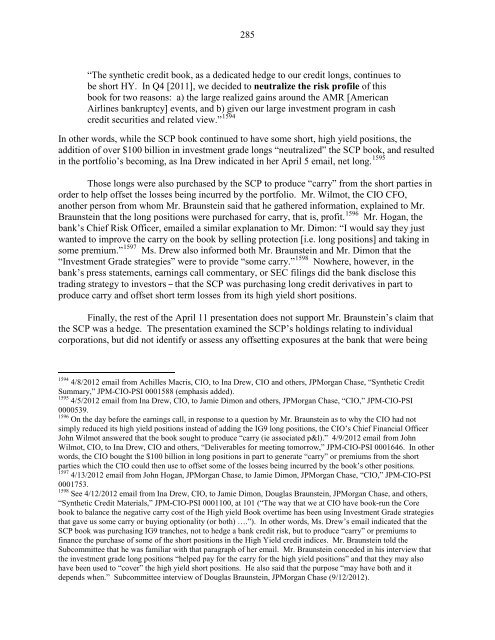JPMORGAN CHASE WHALE TRADES: A CASE HISTORY OF DERIVATIVES RISKS AND ABUSES
JPMORGAN CHASE WHALE TRADES: A CASE HISTORY OF DERIVATIVES RISKS AND ABUSES
JPMORGAN CHASE WHALE TRADES: A CASE HISTORY OF DERIVATIVES RISKS AND ABUSES
Create successful ePaper yourself
Turn your PDF publications into a flip-book with our unique Google optimized e-Paper software.
285<br />
“The synthetic credit book, as a dedicated hedge to our credit longs, continues to<br />
be short HY. In Q4 [2011], we decided to neutralize the risk profile of this<br />
book for two reasons: a) the large realized gains around the AMR [American<br />
Airlines bankruptcy] events, and b) given our large investment program in cash<br />
credit securities and related view.” 1594<br />
In other words, while the SCP book continued to have some short, high yield positions, the<br />
addition of over $100 billion in investment grade longs “neutralized” the SCP book, and resulted<br />
1595<br />
in the portfolio’s becoming, as Ina Drew indicated in her April 5 email, net long.<br />
Those longs were also purchased by the SCP to produce “carry” from the short parties in<br />
order to help offset the losses being incurred by the portfolio. Mr. Wilmot, the CIO CFO,<br />
another person from whom Mr. Braunstein said that he gathered information, explained to Mr.<br />
Braunstein that the long positions were purchased for carry, that is, profit. 1596 Mr. Hogan, the<br />
bank’s Chief Risk Officer, emailed a similar explanation to Mr. Dimon: “I would say they just<br />
wanted to improve the carry on the book by selling protection [i.e. long positions] and taking in<br />
some premium.” 1597 Ms. Drew also informed both Mr. Braunstein and Mr. Dimon that the<br />
“Investment Grade strategies” were to provide “some carry.” 1598<br />
Nowhere, however, in the<br />
bank’s press statements, earnings call commentary, or SEC filings did the bank disclose this<br />
trading strategy to investors – that the SCP was purchasing long credit derivatives in part to<br />
produce carry and offset short term losses from its high yield short positions.<br />
Finally, the rest of the April 11 presentation does not support Mr. Braunstein’s claim that<br />
the SCP was a hedge. The presentation examined the SCP’s holdings relating to individual<br />
corporations, but did not identify or assess any offsetting exposures at the bank that were being<br />
1594 4/8/2012 email from Achilles Macris, CIO, to Ina Drew, CIO and others, JPMorgan Chase, “Synthetic Credit<br />
Summary,” JPM-CIO-PSI 0001588 (emphasis added).<br />
1595 4/5/2012 email from Ina Drew, CIO, to Jamie Dimon and others, JPMorgan Chase, “CIO,” JPM-CIO-PSI<br />
0000539.<br />
1596 On the day before the earnings call, in response to a question by Mr. Braunstein as to why the CIO had not<br />
simply reduced its high yield positions instead of adding the IG9 long positions, the CIO’s Chief Financial Officer<br />
John Wilmot answered that the book sought to produce “carry (ie associated p&l).” 4/9/2012 email from John<br />
Wilmot, CIO, to Ina Drew, CIO and others, “Deliverables for meeting tomorrow,” JPM-CIO-PSI 0001646. In other<br />
words, the CIO bought the $100 billion in long positions in part to generate “carry” or premiums from the short<br />
parties which the CIO could then use to offset some of the losses being incurred by the book’s other positions.<br />
1597 4/13/2012 email from John Hogan, JPMorgan Chase, to Jamie Dimon, JPMorgan Chase, “CIO,” JPM-CIO-PSI<br />
0001753.<br />
1598 See 4/12/2012 email from Ina Drew, CIO, to Jamie Dimon, Douglas Braunstein, JPMorgan Chase, and others,<br />
“Synthetic Credit Materials,” JPM-CIO-PSI 0001100, at 101 (“The way that we at CIO have book-run the Core<br />
book to balance the negative carry cost of the High yield Book overtime has been using Investment Grade strategies<br />
that gave us some carry or buying optionality (or both) ….”). In other words, Ms. Drew’s email indicated that the<br />
SCP book was purchasing IG9 tranches, not to hedge a bank credit risk, but to produce “carry” or premiums to<br />
finance the purchase of some of the short positions in the High Yield credit indices. Mr. Braunstein told the<br />
Subcommittee that he was familiar with that paragraph of her email. Mr. Braunstein conceded in his interview that<br />
the investment grade long positions “helped pay for the carry for the high yield positions” and that they may also<br />
have been used to “cover” the high yield short positions. He also said that the purpose “may have both and it<br />
depends when.” Subcommittee interview of Douglas Braunstein, JPMorgan Chase (9/12/2012).



